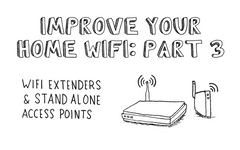Payment methods accepted

Fiber Optics In The Home - Why and When?
Written by Ben Hamlitsch, trueCABLE Technical and Product Innovation Manager RCDD, FOI
First, we should understand: What Is Fiber To The Home Technology?
“Fiber to the home” describes the use of fiber optic cable to deliver broadband internet from a central location directly to private residences. In an FTTH network, fiber cable is used over the “last mile” in place of lower bandwidth DSL and coaxial wires.
Fiber to the home is one of many “fiber-to-the-x” (FTTx) network designs. For example, many network developers build out fiber-to-the-premises (FTTP) or fiber-to-the-building (FTTB) networks, in which fiber cable runs all the way to consumer properties and organizational structures. Many homes have internet today thanks to fiber-to-the-curb (FTTC) and fiber-to-the-neighborhood (FTTN) networks, which transmit communication signals to a certain point and then transfer data to other last-mile cable customers.
To homeowners, FTTH means faster internet and more bandwidth. Consumers can stream richer media and enjoy higher-quality interactivity. Additionally, FTTH can support triple play services, which means that internet, TV and phone can be bundled together and provided over one broadband connection.
To network developers, FTTH is a “future proof” solution that will facilitate high-speed connectivity capabilities over the long term. Fiber cable has virtually unlimited capacity and is just as cost effective when it comes to actually delivering service.
FTTH being the hot topic in much of the industry, Internet Service Providers are working hard to lay the infrastructure needed to allow for higher bandwidth and faster speed internet to the home.
What about FITH (Fiber In the Home)? I am not referring to FTTH which we just talked about where the internet is brought, in most cases, to the outside of the customer’s home by the Internet Service Provider.
Below is a typical FTTH PON architecture from Central office to the home, MDU or business.

Fiber In The Home refers to wiring your home’s structured wiring with fiber optics. This means to each of the wall plate locations, to any outdoor areas where data connections are needed, back to the distribution location in the garage or closet designated in the house. It often is also a structured wiring panel in the home where all the voice/data/video drops are located.

In today’s fast-growing and ever-changing need for more and more speed and bandwidth to the home, fiber cable is becoming more and more recognized as the superior way to wire for future applications. In the enterprise and data centers we are already seeing 40GB, 100GB and even up to 400GB bandwidth applications.
Those data speeds are not quite to the home yet but it’s only a matter of time before we are seeing these same bandwidth needs in residential applications. Commercial application needs for more bandwidth as cloud computing, video streaming and a whole host of other applications, have driven data bandwidth needs higher and higher. This same need will continue and as copper cabling starts to come to the end of its life in terms of bandwidth, we will see fiber take over.
In today’s applications in the home, many of the IOT devices may require power as well as data or may just require power and the data is Wi-Fi. Many of the network interfaces are still copper based and PoE is a big factor in using copper cabling.
The TIA 570-D, which is the residential cabling standard, already has a cabling grading system which includes fiber optic cabling in the single-dwelling residence. And is especially used in any operational lengths that may exceed the 100-meter limit for copper cabling.
Residential wiring Grade 6.2.2.3 Grade 3 for each cabled location, grade 3 provides a generic cabling system that meets the minimum requirements for basic and advanced telecommunications services such as high-speed internet, wireless access points and in-home generated video. This grade provides for both current and developing telecommunications services. Grade 3 specifies balanced twisted-pair cabling, coaxial cabling, and optical fiber cabling. Grade 3 cabling requirements consist of a minimum of two 4-pair balanced twisted-pair cables that meet or exceed the requirements for category 6A, a minimum of one broadband coaxial cable, and a minimum of one 2-fiber optical fiber cable, and their respective connectors at each equipment outlet and the distribution device (DD).
Benefits of Fiber over Copper
As we can see here fiber optics are already part of the residential wiring recommendations in the grade 3 requirement. As the price of the optical electronics used in fiber optics transmission of data decreases, we will see a bigger push for fiber in the home. Some of the great benefits of fiber optic cabling vs Copper cabling are:
Speed. Fiber is far more capable of transmitting faster and larger amounts of data.
Reach (distance). Fiber optic cables are the better choice if you need to send a signal over greater distances. Copper cables can only carry signals about 100 meters, while some singlemode fiber optic cables can carry more data up to 25 miles. Fiber optic cable also carries data with less attenuation, or signal loss—only about three percent every 100 meters in comparison to copper, which loses over 90 percent over the same distance.
Reliability. Fiber Optics are extremely reliable. Fiber uses a process known as total internal reflection to carry light signals instead of electricity, so it’s not bothered by electromagnetic interference (EMI) that can interrupt data transmission. Fiber is also immune to temperature changes, severe weather, and moisture, all of which can hamper the connectivity of copper cable. Plus, fiber does not present a fire hazard like old or worn copper cables can.
Durability. Fiber Optic cables can withstand a pulling force up to 200 pounds of pressure, which is certainly preferable during construction of a local area network (LAN).
Longevity. Copper cables also experience corrosion and will eventually have to be replaced after as little as five years. Their performance degrades as they age, even to the point where they lose their signal all together. Fiber optic cables, on the other hand, are sturdier with fewer parts and can last up to 50 years. When you’re choosing a cable, its longevity is very important.
Security. Your data is much more secure with fiber optic cables, which don’t carry electrical signals and are almost impossible to tap into. Even if a cable is compromised or damaged, it can easily be detected by monitoring the power transmission. Copper cables, on the other hand, can still be tapped, which could affect your internet speed or even destroy your network.
So, with all these advantages why not install fiber in the home? More and more fiber systems are being installed into the home as well as the MDU (multi dwelling unit). Much of the fiber that is getting installed is being used in the backbone cabling of the installation and in some cases installed to the equipment outlet.
What type of fiber cable is being installed in the residential installation? Well, that may all depend in the application needed. In many cases multimode OM3 or OM4 fiber is a good choice and will future proof much of the network for years to come.
Considering even singlemode fiber can be very practical. Many fiber internet service providers are bringing singlemode fiber to the home. Continuing with singlemode for the fiber part of the installation may make sense and will certainly future proof you structured wiring installation for years to come. It is advantages for one of those super long camera runs at the end of the gate or entrance to the residence where the length is well over 100 meters and the video streaming quality needs to be high definition back to the distribution equipment. Or there may be outbuildings such as a barn or office location that needs high speed data and video requiring high quality and excellent reliability. These are just some ways where fiber optic cabling systems can shine.
Frequently Asked Questions
Is fiber optic Internet faster than cable?
Yes, fiber optics can transmit data at speeds up to 100 times faster than traditional copper cables.
Are fiber optic cables durable?
Yes, fiber optic cables are immune to electromagnetic interference and offer a longer lifespan than traditional cables.
Is fiber optic installation expensive?
While the initial cost might be slightly higher than traditional copper cabling, fiber optics offer longer-term benefits and savings.
Can I install fiber optic cables myself?
Yes it is something that can be installed yourself. However while some homeowners may choose to install fiber optics themselves, it's recommended to hire a professional for a successful installation.
Does fiber optic increase home value?
Yes, a home equipped with a fiber optic structured wiring system can command a higher price in the real estate market.
STAY CONNECTED
trueCABLE presents the information on our website, including the “Cable Academy” blog and live chat support, as a service to our customers and other visitors to our website subject to our website terms and conditions. While the information on this website is about data networking and electrical issues, it is not professional advice and any reliance on such material is at your own risk.

































